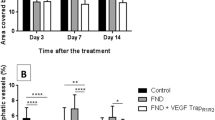Abstract
Purpose
Inflammatory corneal hem- and lymphangiogenesis occurring both prior to as well as after penetrating keratoplasty significantly increase the risk for subsequent immune rejections. The purpose of this study was to analyze whether the blocking anti-VEGFR3 antibody mF4-31C1 is able to inhibit the outgrowth of pathologic new lymphatic vessels in a mouse model of suture-induced, inflammatory corneal neovascularisation, and whether this antibody specifically inhibits lymphangiogenesis without affecting hemangiogenesis.
Methods
Three interrupted 11-0 nylon sutures were placed into the corneal stroma of BALB/c mice (6 weeks old) and left in place for 7 days to induce neovascularisation. The treatment group (n = 9) received the anti-VEGFR3 antibody mF4-31C1 intraperitoneally on the day of surgery and 3 days later (0.5 mg/mouse). Control mice received an equal amount of control IgG solution. For immunohistochemistry, corneal flat mounts were stained with LYVE-1 as a specific lymphatic vascular endothelial marker and with CD31 as panendothelial marker. Morphometry was performed with the image analysis software analySIS^B (Soft Imaging Systems GmbH, Münster, Germany). To improve the objectivity and precision of the morphometrical analysis, we established a modified method using grey filter sampling on monochromatic pictures.
Results
The mF4-31C1 antibody-treated mice displayed nearly complete inhibition of lymphangiogenesis compared with IgG controls (p < 0.006). In contrast, there was no significant inhibitory effect observed with respect to blood vessel growth (p > 0.05).
Conclusions
Inflammatory corneal lymphangiogenesis seems to depend on VEGFR3-signalling. By blocking this receptor the ingrowths of lymphatic vessels can be inhibited almost completely, and specifically without affecting hemangiogenesis. This may open new treatment options to promote (corneal) graft survival without affecting hemangiogenesis.


Similar content being viewed by others
References
Alitalo K, Tammela T, Petrova TV (2005) Lymphangiogenesis in development and human disease. Nature 438:946–953
Chen L et al (2004) Vascular endothelial growth factor receptor-3 mediates induction of corneal alloimmunity. Nat Med 10:813–815
He Y et al (2002) Suppression of tumor lymphangiogenesis and lymph node metastasis by blocking vascular endothelial growth factor receptor 3 signaling. J Natl Cancer Inst 94:819–825
Skobe M et al (2001) Induction of tumor lymphangiogenesis by VEGF-C promotes breast cancer metastasis. Nat Med 7:192–198
Cursiefen C et al (2004) VEGF-A stimulates lymphangiogenesis and hemangiogenesis in inflammatory neovascularization via macrophage recruitment. J Clin Invest 113:1040–1050
Achen MG et al (1998) Vascular endothelial growth factor D (VEGF-D) is a ligand for the tyrosine kinases VEGF receptor 2 (Flk1) and VEGF receptor 3 (Flt4). Proc Natl Acad Sci USA 95:548–553
Jeltsch M et al (1997) Hyperplasia of lymphatic vessels in VEGF-C transgenic mice. Science 276:1423–1425
Joukov V et al (1996) A novel vascular endothelial growth factor, VEGF-C, is a ligand for the Flt4 (VEGFR-3) and KDR (VEGFR-2) receptor tyrosine kinases. Embo J 15:1751
Kaipainen A et al (1995) Expression of the fms-like tyrosine kinase 4 gene becomes restricted to lymphatic endothelium during development. Proc Natl Acad Sci USA 92:3566–3570
Makinen T et al (2001) Isolated lymphatic endothelial cells transduce growth, survival and migratory signals via the VEGF-C/D receptor VEGFR-3. Embo J 20:4762–4773
Schoppmann SF et al (2006) Hypoxia inducible factor-1alpha correlates with VEGF-C expression and lymphangiogenesis in breast cancer. Breast Cancer Res Treat
Schoppmann SF et al (2002) Tumor-associated macrophages express lymphatic endothelial growth factors and are related to peritumoral lymphangiogenesis. Am J Pathol 161:947–956
Lymboussaki A et al (1998) Expression of the vascular endothelial growth factor C receptor VEGFR-3 in lymphatic endothelium of the skin and in vascular tumors. Am J Pathol 153:395–403
Cursiefen C (2007) Angiogenic and immune privilege. In: Niederkorn JY (ed) Ocular Immunology. Karger, New York (in press)
Cursiefen C et al (2004) Inhibition of hemangiogenesis and lymphangiogenesis after normal-risk corneal transplantation by neutralizing VEGF promotes graft survival. Invest Ophthalmol Vis Sci 45:2666–2673
Cursiefen C et al (2003) Corneal lymphangiogenesis: evidence, mechanisms, and implications for corneal transplant immunology. Cornea 22:273–281
Cursiefen C et al (2005) Spontaneous corneal hem- and lymphangiogenesis in mice with destrin-mutation depend on VEGFR3 signaling. Am J Pathol 166:1367–1377
Cursiefen C et al (2006) Time course of angiogenesis and lymphangiogenesis after brief corneal inflammation. Cornea 25:443–447
Cursiefen C et al (2006) Nonvascular VEGF receptor 3 expression by corneal epithelium maintains avascularity and vision. Proc Natl Acad Sci USA 103:11405–11410
Hamrah P et al (2003) Novel expression of vascular endothelial growth factor receptor (VEGFR)-3 and VEGF-C on corneal dendritic cells. Am J Pathol 163:57–68
Maruyama K et al (2005) Inflammation-induced lymphangiogenesis in the cornea arises from CD11b-positive macrophages. J Clin Invest 115:2363–2372
Xu H et al (2007) LYVE-1-positive macrophages are present in normal murine eyes. Invest Ophthalmol Vis Sci 48:2162–2171
Dietrich T et al (2007) Inhibition of inflammatory lymphangiogenesis by integrin {alpha}5 blockade. Am J Pathol 171:361–372
Acknowledgments
The authors thank D.G. Jackson, Oxford for the Lyve-1 antibody and Elke Lütjen-Drecoll, Erlangen for general help.
Author information
Authors and Affiliations
Corresponding author
Additional information
Interdisciplinary Centre for Clinical Research (IZKF) Erlangen (A9), ELAN Funds Erlangen, DFG (Cu 47/2-1).
Rights and permissions
About this article
Cite this article
Bock, F., Onderka, J., Dietrich, T. et al. Blockade of VEGFR3-signalling specifically inhibits lymphangiogenesis in inflammatory corneal neovascularisation. Graefes Arch Clin Exp Ophthalmol 246, 115–119 (2008). https://doi.org/10.1007/s00417-007-0683-5
Received:
Revised:
Accepted:
Published:
Issue Date:
DOI: https://doi.org/10.1007/s00417-007-0683-5




